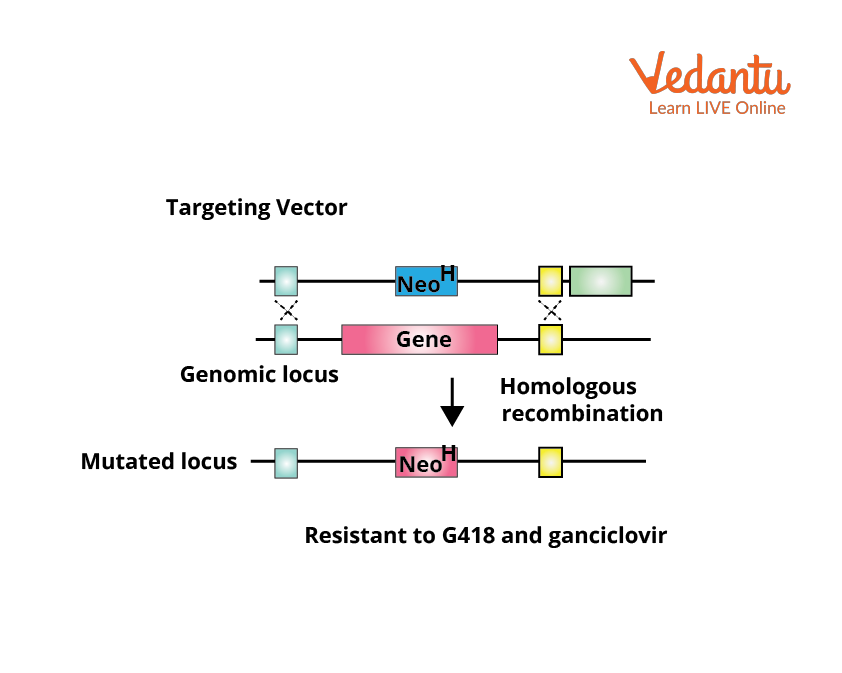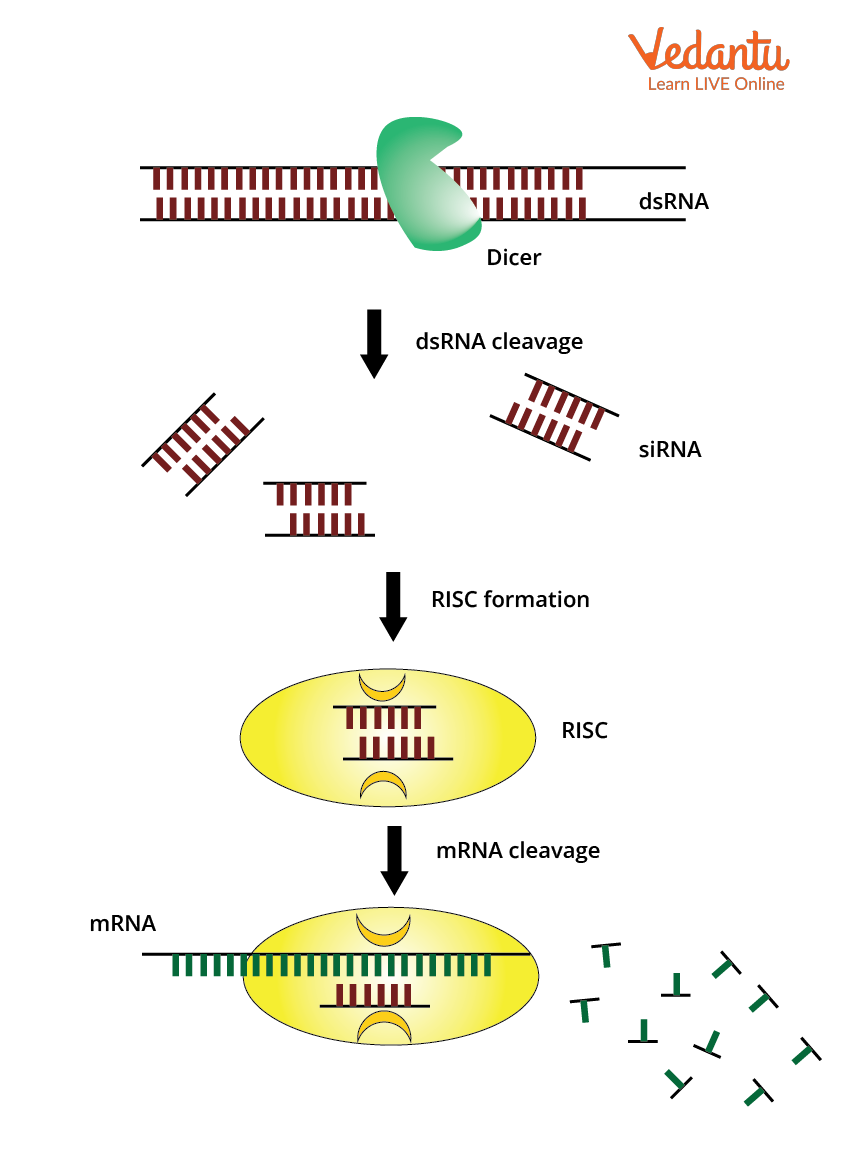When to Use Gene Knockout or Knockdown: Practical Insights for Students
Gene knockdown is a technique that enables interim inactivation of genes. In this method, the mRNA is deactivated using interfering RNA (RNAi). These snRNA and SiRNA form the duplex with target mRNA, resulting in its degradation by the DICER and RISC complex. A recent knockout gene study was performed to find the effect of the Xirp 2 gene in Brugada and SUNDS syndrome.
Xirp2 knockout mice were created, and the study revealed the role of Xirp2 in cardiac function. Gene Knockout permanently deletes the gene from the genome by introducing frameshift or nonsense mutation. This alters the genetic code resulting in alteration in the expression of the genome. Recently knockout mice have been used to study the effect of genes on human health.
Gene Knockout Definition
Gene knockout is an irreversible biotechnological method to make genes nonfunctional in an organism. The organisms in which one or more genes are removed are called knockout organisms. These organisms are vital genetic models to screen for the effect of certain genes on human health. They play important roles in the drug development process; study the effect of lethal genes and important biological concepts. Gene knock-out methods are a reverse process to annotate genes whose function is unknown.
Gene Knockout Technology
The best method to create a knockout organism is the homologous recombination method. This technique erases a single gene without altering the functioning of another gene present in an organism.
Homologous Recombination Method
The exchange of genetic material between sister chromatids is called homologous recombination.
It is the most widely traditional method used for knocking out genes.
A novel DNA segment with a selectable marker gene is constructed in vitro. The new DNA construct must have a 2 Kb homology with the target gene that has to be eliminated.
The DNA construct is incorporated into embryonic stem cells isolated from the blastocyst of the model organism by using the microinjection or electroporation method.
Homologous recombination event is a default mechanism occurring in all the cells. The crossing-over event will occur between the new DNA construct and the target gene.
The target genes get exchanged by marker genes flanked by homologous sequence bringing about loss of function.
The transformed stem cells are screened from untransformed ones and can be delivered to early embryos.
The efficiency of homologous recombination is less (10-2 to 10-3) several new methods are devised to bring about gene knockout.

Gene Knockout by Homologous Recombination
Non-Homologous End Joining (NHEJ): It is a repair mechanism that can seal double-strand breaks in DNA without the need for a homologous template. During this ligation process, NHEJ integrates small insertions or deletions at the breakpoints. This leads to frameshift disrupting gene function.
Zinc-Fingers: These are restriction endonucleases integrated with specific binding domains. These recognise the desired codon or segment of DNA and bind to the target site. Binding is coupled with endonucleases activity which breaks the double strands of DNA. The repair mechanism mutates the target DNA sequence creating a loss of function.
CRISPR: It means clustered regularly interspaced short palindromic repeats. In this technique, the Cas enzyme cuts the target DNA at a specific site. Cas is integrated with RNA – guided endonuclease activity.
The guide RNA is constructed in accordance with the target gene for specific recognition. Once the target gene is identified, the Cas 9 enzyme cleaves the double-stranded DNA. The repair mechanism creates insertion and deletion, altering the gene function. This destructs the target gene and makes it non-functional.
Gene Knock Down
It is a molecular biological technique to suppress gene expression. This is done at the transcriptional level by modifying the mRNA sequences. Gene knockdown is a temporary method to decrease the activity of genes. As mRNA is alerted, the genomes of the organism do not get affected.
Gene Knock Down Technologies
RNA Interference: It is a technique to suppress or silence a gene by degrading its transcriptional mRNA. Small double-stranded siRNA (small interfering RNA) are inserted exogenously into the target cell. The sequence siRNA is designed complementary to the target mRNA. This results in the formation of double-stranded mRNA, which is then degraded by RISC (RNA-induced silencing complex) and has ribonuclease activity. Thus, resulting in the suppression of genes.

Knockdown by RNA Pathway
DNA-Based RNA Interference: In this technique, antisense oligonucleotides are constructed. These are 15 to 20 base long DNA sequences designed in antisense orientation to the target mRNA.
CRISPR Cas 13 Enzymes: This is generally used as gene knockout technology. In this method, rather than using Cas 9 enzyme, which targets DNA, Cas 13 enzymes are used. This enzyme directly targets RNA and degrades them. Using Cas 13 enzymes in cellular machinery will degrade mRNA, but the host DNA remains intact.
Differences Between Gene Knockout and Gene Knockdown
Interesting Facts
The year 2013 is considered after the CRISPR era and is the most recent endonuclease-based genetic engineering tool.
With the use of CAS enzymes, gene editing pigs are considered as best models for research in human disease and are potent models for xenotransplantation.
With help of new gene editing methods, it is easy to induce point mutations in the porcine genome of pigs that encodes for xenoantigen and are a recent model to understand human disease mutation.
Important Questions
1. Explain Genetically Modified Organisms (GMO).
Ans: Genetically modified organisms are engineered organisms created in the laboratory. expressing desired characteristics. GMOs are created using recombinant DNA technology. Example - Dolly, Bt cotton, etc.
2. Explain RNA interference Mechanism.
Ans: It is a post-transcriptional regulatory mechanism to control gene activity. The siRNA shows homology with mRNA and thus forms a DICER complex which cleaves the mRNA, thereby stopping translation.
Key Features
Gene knockout erases the gene permanently in an organism. This technique is used for drug discovery, understanding the gene effect, etc.
Gene knockdown suppresses the activity of genes at the transcriptional level.


FAQs on Gene Knockout vs Gene Knockdown: Understanding the Differences
1. What is the primary difference between gene knockout and gene knockdown?
The primary difference lies in the permanence and level of genetic modification. A gene knockout permanently deletes or inactivates a gene at the DNA level, making it a stable and heritable change. In contrast, gene knockdown temporarily suppresses a gene's expression by targeting its mRNA, which prevents protein production. This effect is transient and not passed on to future generations.
2. How does RNA interference (RNAi) achieve gene knockdown?
RNA interference (RNAi) uses small, custom-designed RNA molecules, typically siRNA (small interfering RNA), which are complementary to the target gene's messenger RNA (mRNA). These siRNAs guide a cellular machine called the RISC (RNA-Induced Silencing Complex) to bind to the target mRNA. Once bound, RISC cleaves the mRNA, leading to its degradation and effectively silencing the gene's expression without altering the organism's DNA.
3. What are the main technologies used for creating a gene knockout?
The most common and important techniques for creating a gene knockout, as per the CBSE syllabus, include:
- Homologous Recombination: A traditional method where the target gene in embryonic stem cells is precisely replaced with a non-functional, engineered DNA construct.
- CRISPR-Cas9: A modern and highly efficient gene-editing tool that uses a guide RNA (gRNA) to direct the Cas9 enzyme to a specific DNA site, creating a double-strand break that inactivates the gene through the cell's repair process.
4. Why would a researcher choose gene knockdown over a complete gene knockout?
A researcher might prefer gene knockdown for several critical reasons. If a gene is essential for survival (a lethal gene), knocking it out completely would kill the cell or organism, making it impossible to study. Gene knockdown only reduces the gene's expression, allowing researchers to study the effects of its partial loss. Furthermore, knockdown is generally faster, less expensive, and its temporary nature is ideal for studying gene function at specific developmental stages or in adult organisms.
5. Is gene knockdown the same as gene silencing?
The terms are related but not identical. Gene silencing is a broad term for any process that stops a gene from being expressed. Gene silencing can happen at two levels:
- Transcriptional Silencing: Preventing the gene's DNA from being transcribed into mRNA (e.g., via a knockout).
- Post-transcriptional Silencing: Preventing the mRNA from being translated into a protein.
6. How does a gene knock-in differ from a gene knockout?
The key difference is the objective of the genetic modification. A gene knockout aims to study the loss of function by deleting or inactivating a gene. Conversely, a gene knock-in involves inserting a new gene or replacing an existing gene with a modified version to study a gain of function. For example, researchers might knock in a human disease gene into a mouse to create a model for studying that illness.
7. Is a gene knockout heritable, and why is this important?
Yes, a gene knockout is heritable if the genetic modification is made in germline cells (like embryonic stem cells), which form all tissues of an organism, including its reproductive cells. This is crucial for research because it allows scientists to create stable lines of knockout animals (e.g., mice) where the trait is passed down through generations. This provides a consistent and reliable model for studying the long-term effects of the gene's absence.
8. What are some important real-world applications of gene knockout and knockdown?
Both techniques are fundamental to modern biology and medicine. Their applications include:
- Understanding Gene Function: The most direct way to discover what a gene does is to see what happens when it's gone.
- Creating Disease Models: Developing animal models (e.g., knockout mice for cancer or Alzheimer's) to understand disease mechanisms and test new drugs.
- Drug Discovery and Validation: Identifying potential drug targets by knocking down a gene to see if it halts a disease process, thereby validating it as a target for a new medicine.










